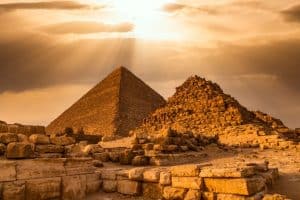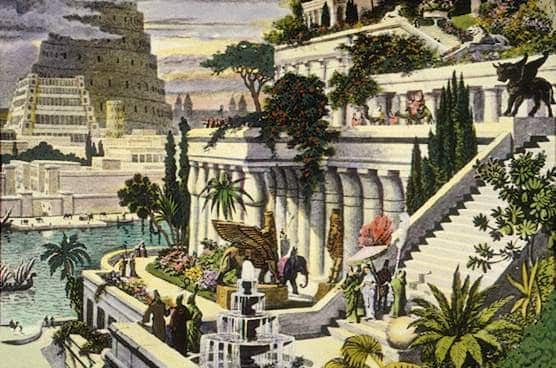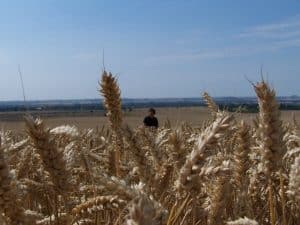The Hanging Gardens of Babylon were one of the Seven Wonders of the Ancient World, and it is believed that they were built by King Nebuchadnezzar II around 600 BCE. The gardens were thought to have been a paradise on earth, with beautiful flowers and plants, and even trees. The gardens were also said to have been irrigated by a complex system of pumps and canals.
Why were the Hanging Gardens of Babylon built?
The legend of the Hanging Gardens says that they were built for Queen Amytis of Media, who was married to Nebuchadnezzar II.
Amyitis, the daughter of the Medes’ king, married Nebuchadnezzar in order to forge an alliance between the two nations. Her homeland was green, rugged, and mountainous, and she found Mesopotamia’s flat, sun-baked terrain depressing. The king decided to cheer her up by constructing an artificial mountain with rooftop gardens in her honor.
Whether the gardens actually existed is still debated by historians, but they remain one of the most fascinating legends of the ancient world.
The design and construction of the gardens
The gardens were built on a series of terraces, with walls and pillars supporting the weight of the soil and plants. The terraces were watered using a system of pumps and canals, which carried water up from the Euphrates River.
According to the Greek historian Diodorus, they were approximately 100 feet wide by 100 feet long and more than 80 feet high. The gardens were built in tiers to resemble a theater.

It is made up of vaulted terraces that are raised one above the other and supported by cube-shaped pillars. These are hollow and filled with earth to accommodate the largest trees. Baked brick and asphalt are used to build the pillars, vaults, and terraces.
The ascent to the highest story is by stairs, and at their side are water engines, with which persons appointed specifically for the purpose are constantly employed in raising water from the Euphrates into the garden.
Whatever their purpose, the hanging gardens of Babylon were an engineering feat, and a stunning example of human achievement.
The plants and flowers used in the gardens
Big trees were planted on the first eight-meter-high terrace: plane trees, palm trees – date palms, pines, and cedars. Cypresses and a variety of fruit trees were planted on the second thirteen-meter-high terrace. Even higher, on the two final terraces, which were less expansive than the others, we could find anemones and tulips, lilies, irises, and roses.
The plants and flowers used in the gardens were carefully chosen to create a pleasing and fragrant atmosphere. The gardeners also made use of hanging baskets to display their plants in a more eye-catching way.
Some scholars believe that the gardens may have been used for medicinal purposes, as many of the plants grown there had healing properties. Others believe that they were simply meant to be a beautiful oasis in the midst of a hot, dry desert.
Other wonders of the Ancient world

Wonders of the World: The Enormous Zeus Statue at Olympia
The Zeus statue in Olympia was one of the Seven Wonders of the Ancient World. It was built in 466-456 BC by the artist Phidias.

The 7 wonders of the Ancient World
A number of authors in the second century BC considered the 7 Wonders of the Ancient World to be the most remarkable and inspiring landmarks

7 Surprising Facts About the Great Pyramid of Giza
The Great Pyramid of Giza is one of the most famous structures in the world. It was built over 4,500 years ago and is the
How were the plants watered?
Strabo mentions what was probably the most amazing part of the garden to the ancients. Babylon: it rarely rained! So, the garden had to be irrigated with water from the nearby Euphrates River.
Lifting the water high into the air allowed it to flow down through the terraces, watering the plants on each level. Given the lack of modern engines and pressure pumps in the fifth century B.C., this was a monumental task. However, one solution that the garden’s designers may have used to move the water was a chain pump.
A chain pump (above) is made up of two large wheels that are connected by a chain. Buckets are hung from the chain. A pool with a water source is located beneath the bottom wheel. The buckets dip into the pool and pick up water as the wheel is turned. The buckets are then lifted by the chain to the upper wheel, where they are tipped and dumped into an upper pool. The chain then lowers the empty buckets to be refilled.
Alternatively, they might have used screws to pump the water up. This technique is traditionally associated with Archimedes.
Babylon or Nineveh?
For centuries, the location of the Gardens of Babylon has been a source of dispute.
According to Dr. Stephanie Dalley of Oxford University, the gardens are actually buried in the ancient city of Nineveh, 350 miles away in northern Iraq, near modern-day Mosul. Nineveh was the capital of Assyria at the time the gardens are thought to have existed.
Dr. Dalley was able to combine ancient maps with modern-day versions to locate what she believes to be the ruins of the palace. You can watch the Channel 4 documentary “Finding Babylon’s Hanging Garden” below, if you are interested.
Did the Hanging Gardens of Babylon really exist?
Asking historians about the Hanging Gardens of Babylon, they suggest the gardens might have not existed at all:
- There is no historical reference to Nebuchadnezzar’s wife Amyitis (or any other wives);
- Although there are numerous records of Nebuchadnezzar’s works, none of them mention a garden;
- The Hanging Gardens of Babylon are not mentioned by Herodotus (ancient Greek historian, 484-425BC) in his famous book Histories;
- There is no archaeological evidence for the Hanging Gardens at Babylon. It is possible that evidence exists beneath the Euphrates that cannot be safely excavated at this time.
These historians suggest the Gardens were a product of mythology, and the ever-present inclusion of divine creations (and frankly, exaggerations) on the part of Strabo and many other such philosophers only serves to confirm this.
What happened to the Gardens of Babylon?
The Hanging Gardens of Babylon are believed to have been destroyed by earthquakes and floods, but no archaeological evidence has been found to confirm this.
Good reads











